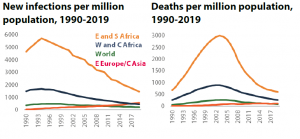HIV is thought to have originated among central African primates. Human infections were first identified in the United States in 1981. In most parts of the world, the epidemic reached its peak around the turn of the century. In southern Africa, the worst affected region, AIDS caused average life expectancy to plunge by nearly 20 years in some countries. Since then, both infection and death rates have declined steadily. In 2019, there were an estimated 690 000 AIDS-related deaths (-59 % compared to the peak in 2005) and 1.7 million new infections (-39 % down on the 1999 peak). The total number of people living with HIV is 38 million.
HIV is most prevalent in eastern and southern Africa, where nearly 7 % of adults are living with the virus. This percentage reaches over 20 % in southern African countries such as Eswatini (27 %), Lesotho (23 %) and Botswana (21 %). However, this is also the region that has seen the biggest progress in terms of curbing new infections (-52 % since 2009). Though starting from a much lower level, new infections in eastern Europe and central Asia are rising fast (+75 %). Certain groups are much more severely affected than others. Although they only represent a small share of the population, gay men, drug users and sex workers, together with their clients and partners, account for the majority of new infections in all regions except for eastern and southern Africa. Although infection rates are mostly similar for men and women, in many African countries young women are far more likely to catch the virus than men.
Progress towards curbing the epidemic
The sustainable development goals adopted by the UN in 2015 envisage ending the HIV/AIDS epidemic by 2030. In 2014, UN agency UNAIDS set three intermediate goals for 2020: at least 90 % of people with the virus should be aware of their status; of these, 90 % should receive treatment, with virus levels in 90 % of patients receiving treatment reduced to a level where no infection is possible. The combined effect of achieving these three targets would be to cut infection rates by three-quarters. Southern and eastern Africa, the worst affected region, has come close to achieving these targets (87 %; 83 %; 93%), helping to explain the dramatic drop in infection rates, while the eastern Europe/central Asia region is one of the worst performers (70 %; 63 %; 93 %), figures that again correlate with sharply rising infections.








Be the first to write a comment.